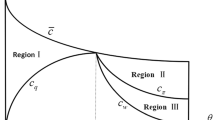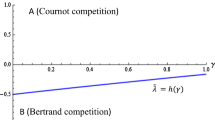Abstract
A regulated upstream monopolist supplies an essential input to firms in a downstream market. If an upstream monopolist vertically integrates downstream, non-price discrimination becomes a concern. Discrimination always arises in equilibrium when the vertically integrated provider (VIP) is no less efficient than its rivals in the downstream market, but it does not always arise when the VIP is less efficient than its rivals. Numerical simulations that parameterize the regulator's ability to monitor discrimination in the case of long-distance telephone service in the U.S. reveal that pronounced efficiency differentials are required for the incentive to discriminate not to arise in equilibrium.
Similar content being viewed by others
References
Armstrong, M., C. Doyle, and J. Vickers. 1996. “The Access Pricing Problem: A Synthesis.” Journal of Industrial Economics 44: 131–150.
Baumol, W., and J. Sidak. 1994. Toward Competition In Local Telephony. Washington, DC: The AEI Press and Cambridge, MA: The MIT Press.
Charnes, A., W. Cooper, and T. Sueyoshi. 1988. “A Goal Programming/Constrained Regression Review of the Bell System Breakup.” Management Science 34: 1–26.
Economides, N. 1988. “The Incentive for Non-Price Discrimination by an Input Monopolist.” International Journal of Industrial Organization 16(3, May): 271–284.
Evans, D., and J. Heckman. 1988. “Natural Monopoly and the Bell System: A Response To Charnes, Cooper and Sueyoshi.” Management Science 34: 27–38.
Hinton, P., J. Zona, R. Schmalensee, and W. Taylor. 1998. “An Analysis of the Welfare Effects of Long-Distance Market Entry by an Integrated Access and Long-Distance Provider.” Journal of Regulatory Economics 13(2, March): 183–196.
Hubbard, R., and W. Lehr. Affidavit on Behalf of AT&T Communications of California, Inc. Notice of Intent to File Section 271 Application of SBC Communications Inc., Pacific Bell, and Pacific Bell Communications Inc., for provision of In-Region, InterLATA Services in California. Before the Public Utilities Commission of the State of California, 1998.
Kahn, A., and T. Tardiff. Testimony Filed with the Missouri Public Service Commission, in Support of the Applications of SBC Communications, Inc., Southwestern Bell Telephone Company, and Southwestern Bell Communications Services, Inc., for Provision of In-Region InterLATA Services in Missouri. Docket No. TO 99–227, November 20, 1998.
Kahn, A. 1998. Letting Go: Deregulating the Process of Deregulation. Lansing, MI: Michigan State University Press.
Kahn, A., and W. Taylor. 1994. “The Pricing of Inputs Sold To Competitors.” The Yale Journal on Regulation 11(1): 225–240.
Krattenmaker, T., and S. Salop. 1986. “Anti-Competitive Exclusion: Raising Rivals' Costs To Achieve Power Over Price.” Yale Law Journal 96(2): 209–293.
Kwoka, J. 1996. Power Structure: Ownership, Integration, and Competition in the U.S. Electric Industry. Boston, MA: Kluwer Academic Publishers.
Laffont, J.-J., P. Rey, and J. Tirole. 1998. “Network Competition: I. Overview and Non-Discriminatory Pricing.” Rand Journal of Economics 29(1): 1–37.
Laffont, J.-J., and J. Tirole. 1996. “Creating Competition Through Interconnection: Theory and Practice.” Journal of Regulatory Economics 10(3, November): 227–256.
Mandy, D. 2000. “Killing the Goose That May Have Laid the Golden Egg: Only the Data Knows Whether Sabotage Pays.” Journal of Regulatory Economics 17(2, March): 157–172.
Nadiri, M., and B. Nandi. 1997. “The Changing Structure of Cost and Demand for the U.S. Telecommunications Industry.” Information Economics and Policy 9(4, December): 319–347.
Reiffen, D. 1998. “A Regulated Firm's Incentive To Discriminate: A Reevaluation and Extension of Weisman's Result.” Journal of Regulatory Economics 14(1, July): 79–86.
Salop, S., and D. Scheffman. 1983. “Raising Rivals' Costs.” American Economic Review 73: 267–271.
Sibley, D., and D. Weisman. 1998A. “The Competitive Incentives of Vertically Integrated Local Exchange Carriers: An Economic and Policy Analysis.” Journal of Policy Analysis and Management 19(1): 74–93.
Sibley, D., and D. Weisman. 1998B. “Raising Rivals' Costs: Entry of an Upstream Monopolist into Downstream Markets.” Information Economics and Policy 10(4, December): 551–570.
Taylor, L. 1994. Telecommunications Demand In Theory and Practice. Boston, MA: Kluwer Academic Publishers.
Ward, M. 1999. “Product Substitutability and Competition In Long-Distance Telecommunications.” Economic Inquiry 37(4, October): 657–677.
Weisman, D. 1995. “Regulation and the Vertically Integrated Firm: The Case of RBOC Entry Into InterLATA Long-Distance.” Journal of Regulatory Economics 8(3, November): 249–266.
Weisman, D. 1998. “The Incentive To Discriminate By A Vertically-Integrated Firm: A Reply.” Journal of Regulatory Economics 14(1, July): 87–91.
Federal Communications Commission, CC Docket 96–98. In the Matter of Implementation of the Local Competition Provisions in the Telecommunications Act of 1996. First Report and Order, Released August 8, 1996.
Federal Communications Commission. Preliminary Statistics of Communications Common Carriers. Washington, DC, 1999.
Federal Communications Commission. Trends in Telephone Service. Washington, DC December 2000. www.fcc.gov/ccb/stats.
Intergraph Corp. v. Intel Corp., 1998–1 Trade Cas. (CCH) Para. 72,126 (N.D. Ala. 1998).
United States of America. v. Microsoft Corp. Civil Action No. 98–1232 (Antitrust) Complaint, D.C. For District of Columbia, May 18, 1998. www.usdoj.gov/atr/cases/ms_index.htm.
Author information
Authors and Affiliations
Rights and permissions
About this article
Cite this article
Weisman, D.L., Kang, J. Incentives for Discrimination when Upstream Monopolists Participate in Downstream Markets. Journal of Regulatory Economics 20, 125–139 (2001). https://doi.org/10.1023/A:1011190911884
Issue Date:
DOI: https://doi.org/10.1023/A:1011190911884




